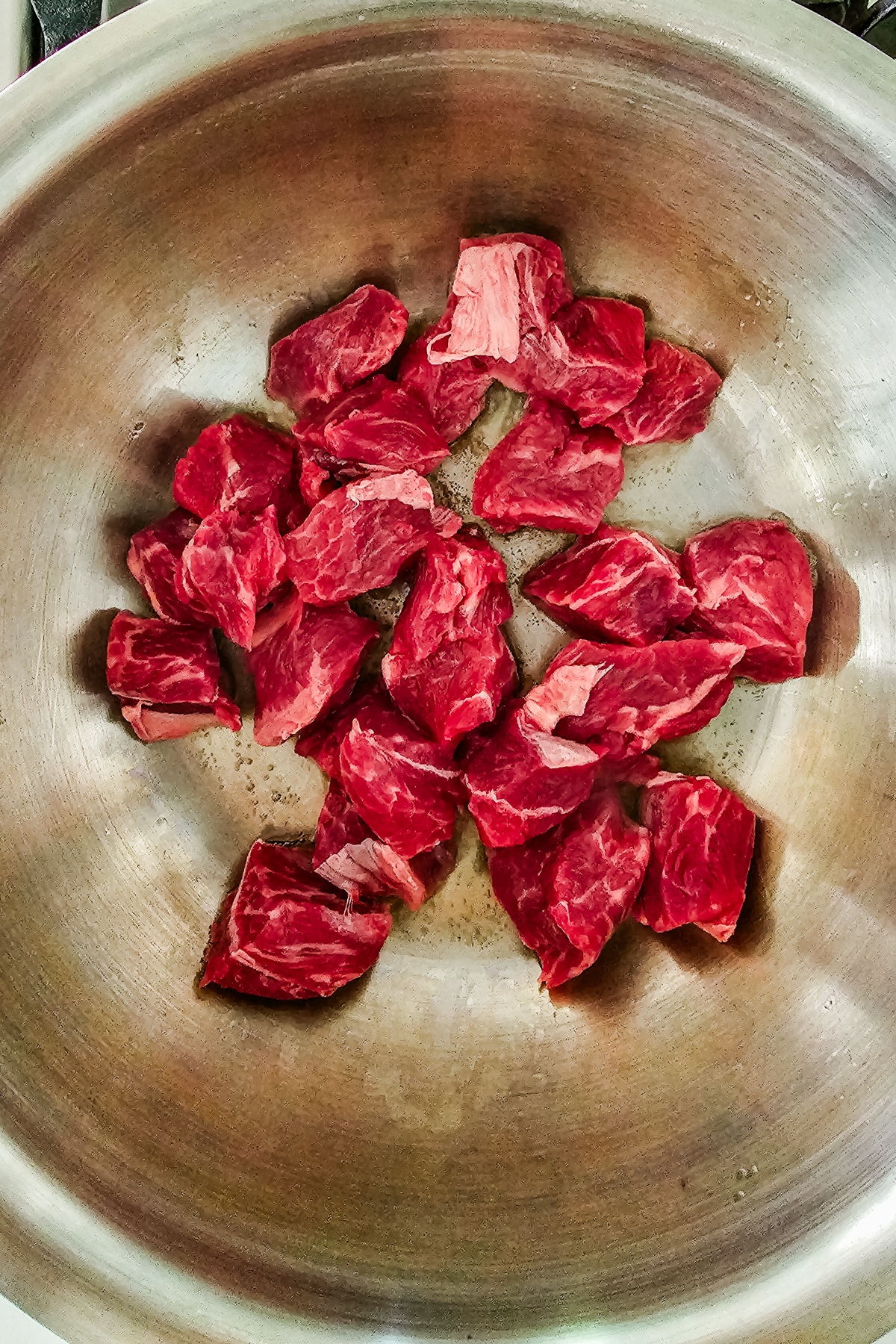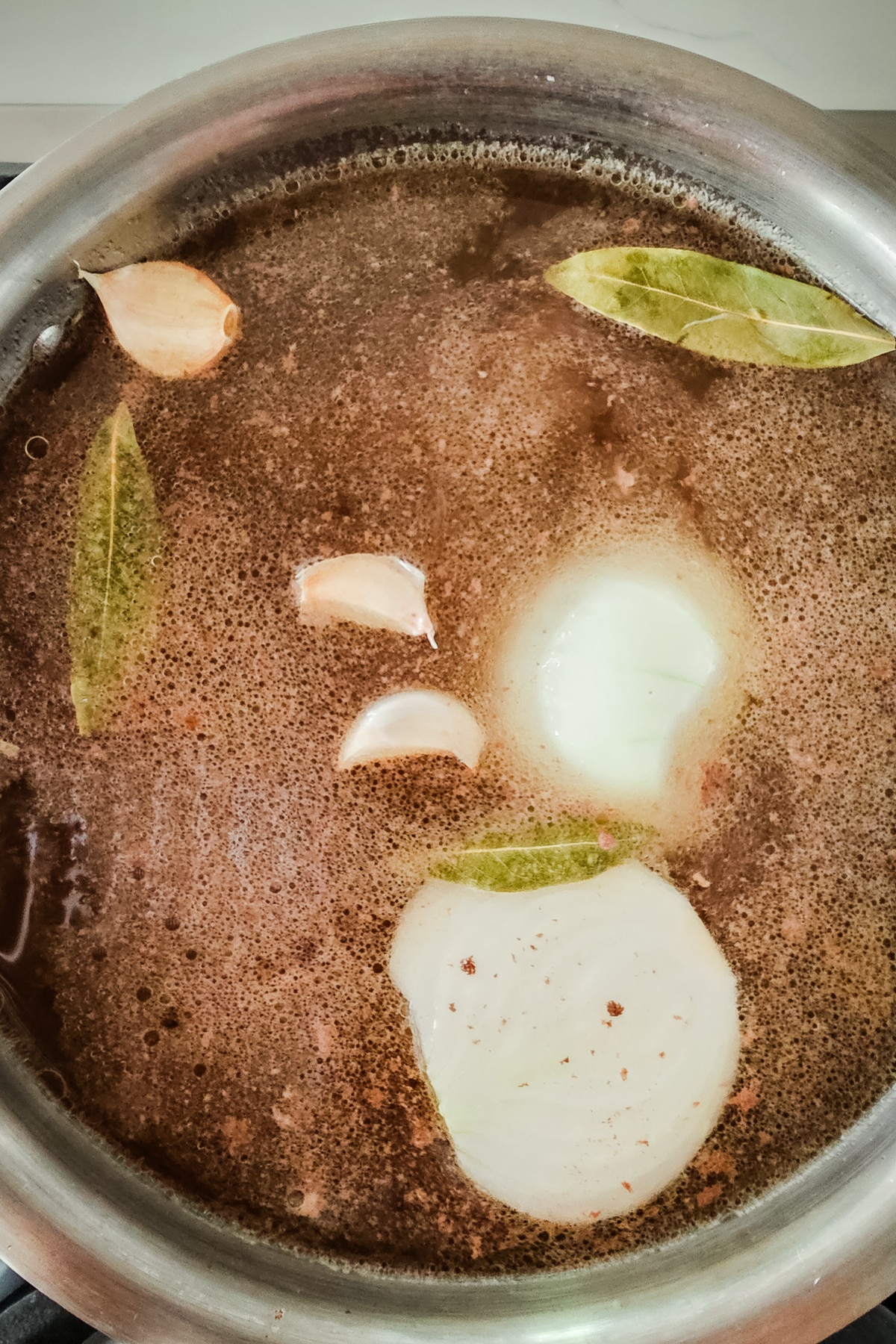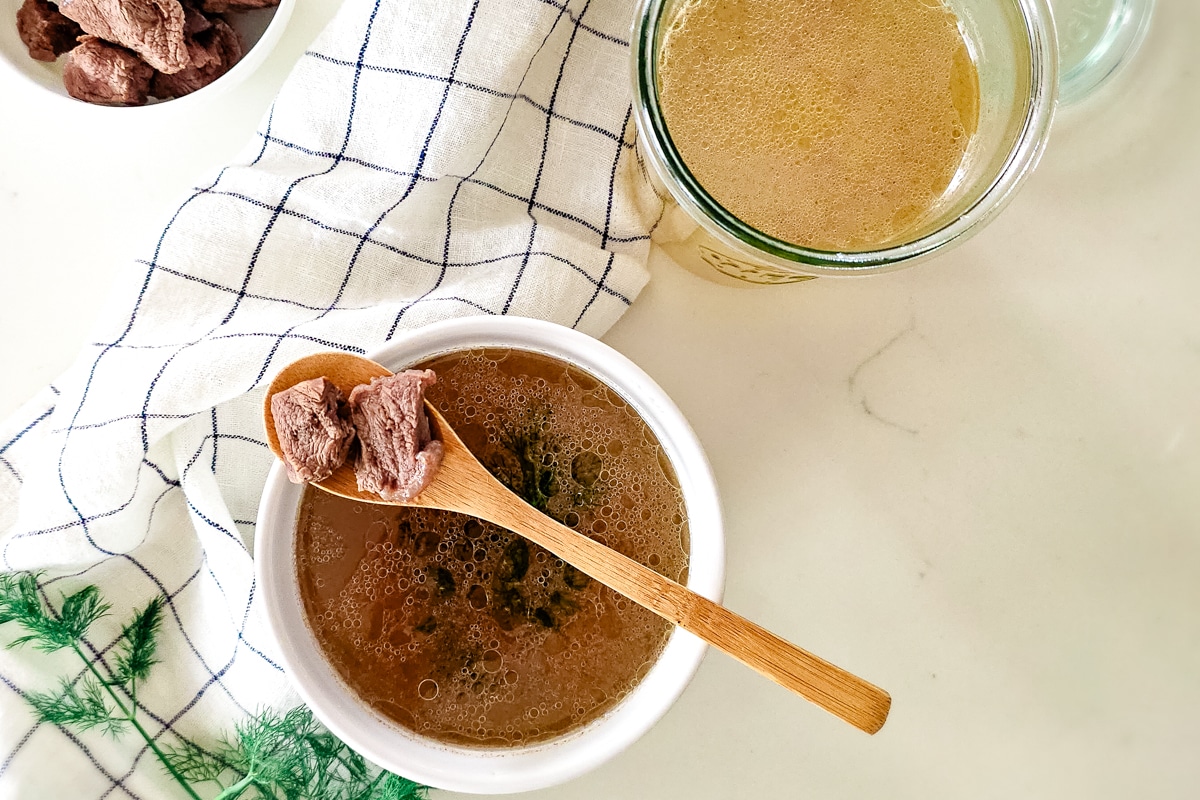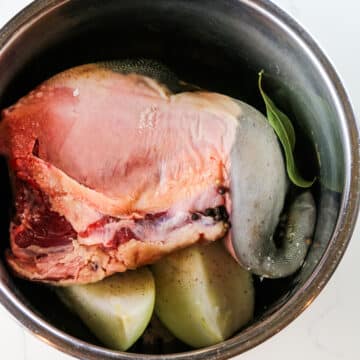Learn how to make meat stock in under 45 minutes! This easy homemade meat broth recipe can be made with chicken, beef, or pork. It's much gentler on the gut than bone broth but still rich in nutrients, minerals, and flavor.

If you're looking for an easy way to include rich, flavorful meat base in your recipes, I have the solution.
Forget the lengthy process of bone broth (certainly, there is a time and place for that!) and say hello to homemade meat broth, the quicker and more convenient solution. It's delicious and a breeze to make, and you can have a batch in less than 45 minutes!
Whether you're craving hearty soups, delicious gravies, or savory sauces, this homemade meat stock recipe offers a budget-friendly approach that delivers flavor without spending all day in the kitchen.
Jump to:
- Why You'll Love This Meat Stock
- Meat Broth vs. Bone Broth
- Is Meat Broth Better Than Bone Broth?
- Ingredients for Meat Broth
- Substitutions and Variations
- Make it Nutrient Dense
- How to Make Meat Stock
- Helpful Tips for Meat Stock
- Tools & Links to Make Meat Broth
- Serving Suggestions
- Storage and Reheating Instructions
- FAQs
- Printable Recipe
Why You'll Love This Meat Stock
Easier on the gut - Meat stock is a gentler option for those with digestive sensitivities and a compromised gut, providing a great alternative to more complex bone broths.
Easy and quick to make - This meat broth offers a hassle-free and time-efficient way to enjoy the benefits of homemade stock without the stress and time involved in traditional bone broth. Ditch the store-bought stock from local grocery stores and make a batch of broth at home.
Versatile uses - From soups to stews, to sauces and many more, meat broth is an invaluable addition to your cooking repertoire.
Have meat and broth - This recipe yields flavorful meat stock and provides you with tender cooked meat that can be repurposed in a variety of dishes. It's a cost-efficient way to get more nutrients in your diet.
💭Fun Fact: Meat stock, often referred to as "bouillon" in French cuisine, was historically used as a beverage in 18th-century Europe, similar to how we enjoy tea or coffee today.
Meat Broth vs. Bone Broth
Meat broth, bone broth, and meat stock are all flavorful bases used in cooking, each with unique characteristics. And in modern-day culinary, those terms are often used interchangeably, yet the preparation and ingredients may vary.
Let's break down what these terms mean and when to use them appropriately.
Meat broth is made by simmering meat, sometimes with vegetables and seasonings, and almost always for a shorter period, typically 1 to 2 hours. It tends to have a lighter flavor, making it ideal for dishes where the meat and other ingredients shine through. Meat broth is often called meat stock. But traditionally, stock is cooked for a longer period than broth.
Bone broth involves simmering bones for an extended period, often up to 12 hours. It may include marrow bones, knuckle bones, or bones with some meat. Sometimes, vegetables and aromatics are involved, and almost always, a splash of acidic medium like apple cider vinegar in chicken broth or red wine in beef bone broth recipe. The long cooking times allows the bones to release collagen and gelatin, resulting in a richer, more gelatinous broth.
The benefits of bone broth are many but not everyone has the time or patience with the cooking process. The good news is that where bone broth fails, meat broth delivers! So if this is your first time, I guarantee you can make a jar of good broth that will nourish and won't leave you in the kitchen all day.

Is Meat Broth Better Than Bone Broth?
In the GAPS diet and gut health context, meat stock is superior to bone broth as it's gentler on the gut for a few key reasons. First, as mentioned, meat stock requires a shorter cooking time than the simmering process of bone broth. This shorter cooking time results in a milder and less complex flavor, making it easier to digest.
Second, meat stock or broth has lower histamine levels than bone broth. Prolonged cooking leads to increased amino acids and the release of histamines, which may aggravate the gut lining of those with leaky gut syndrome. Therefore, meat stock is more tolerable.
Finally, meat stock uses very simple ingredients. It primarily involves simmering meat and minimal seasonings, which is less taxing on the digestive system. It provides a gentler and milder option for gut health.
It's important to note that meat stock and meat broth are used interchangeably in the GAPS healing diet protocol. They are simply broth made with meat. Traditionally, stock is often richer and simmers longer than broth, but in this post, meat stock is much quicker than bone broth because more meat than bones is used.
Ingredients for Meat Broth
Learn how to make meat stock with 5 basic ingredients. This easy recipe takes only 45 minutes.

- Meat: Any meat trimmings will work - I usually use whatever I have on hand. Below are some excellent ideas to make chicken, beef, or pork meat stock. You can also mix and match to get a different flavor profile, but generally, you want to use 2 pounds of meat for 1 gallon of meat stock.
- Aromatics: I use basic staples like yellow onion, whole garlic cloves, bay leaves, and whole peppercorns.
- Sea salt: A generous amount of good quality salt enhances the overall flavor and is always a good addition.
- Water: Enough water to fill a large stock pot. One of the best ways to achieve a flavorful stock is to not dilute the homemade broth too much.
See the recipe card for exact quantities.
Substitutions and Variations
- Chicken stock - Use chicken wings, bone-in, skin-on chicken thighs or chicken breasts, chicken backs, and even whole chicken fryers. This is excellent for any clear soup like chicken soup.
- Beef broth - Use stew meat, beef shanks, oxtails, or short ribs to make homemade beef stock.
- Pork stock - Use pork neck bones, pork chops, pork hocks, or baby back ribs or any meat scraps from pork cuts.
- Flavorings - Feel free to omit or add more seasonings and aromatics as needed. Some like to add carrots, celery, or fresh herbs like parsley or dill to meat stock. I prefer to keep it plain and dress it up in the final dish instead.
Make it Nutrient Dense
Staying true to the heart of what Prepare and Nourish is all about, there are ways to ensure you get the maximum nutrition in this recipe. Even though it's an incredibly simple recipe, you can take purposeful steps keep this in line with a nutrient-dense diet.
Use quality ingredients. Meat broth made from pastured animals will be more nutrient-dense. My favorite sources for grass-fed beef, pastured chicken, and heritage bred pork are your local farmer's markets. But when that's not accessible, Wild Pastures and US Wellness Meats both regularly carry good quality meats.
If sauteeing, use healthy fat. As you'll learn, I prefer to brown my meat first (much like roasting bones in beef bone broth). If you choose to do this, do it with healthy stable fat like beef tallow, pork lard, or chicken schmalz. Avocado oil is also a great choice. The browned bits from sauteeing is a simple way to add rich flavor to broth.
How to Make Meat Stock
The complete printable recipe is below in the recipe card for your convenience. Follow these simple step-by-step instructions for the best results.
The recipe for quick and easy meat stock is very straightforward. The first step is optional but beyond that, all you have to do is add everything to a pot and bring to a gentle simmer.

Step 1. Brown meat
Sear the cuts of meat in beef tallow or avocado oil over medium-high heat. Flip and sear the other side.

Step 2. Add aromatics
Peel the onion and cut it in half. Add to the meat, along with bay leaves, black pepper, garlic, and sea salt.
💭Pro tip: Searing the meat first has three purposes: 1) it creates a Maillard reaction, adding depth of flavor to the meat stock that is akin to roasting bones for bone broth, 2) it reduces the overall scum buildup in the meat stock, and 3) it par-cooks the meat, cutting the overall simmering time in half.

Step 3. Pour water
Add water and bring to a boil over high heat. Once the broth boils, reduce heat to medium.

Step 4. Simmer
Gently simmer until the meat has cooked through and is tender.
💭Pro tip: The total simmering time will depend on the type of meat you use. If you use meaty bones or beef meat, your cooking time will be longer. It's best to cook until the meat is tender and pulls off the bones easily.

Step 5. Strain
Scoop the meat using a slotted spoon and strain the broth through a fine sieve into glass jars.

Step 6. Separate
Transfer the meat back to the meat stock or keep it separate, depending on what your needs are.
Helpful Tips for Meat Stock
Use cold water - Always start with cold water when making stock. Cold water helps extract flavors slowly and evenly from the meat.
Skim the surface - As the stock simmers, skim off any impurities or foam that rise to the surface. This helps ensure a clear and clean-tasting stock. To reduce impurities, consider browning the meat first.
Simmer gently - Maintain a gentle simmer rather than a rolling boil. Vigorous boiling can make the stock cloudy as it breaks down the gelatin.
Don't let meat go to waste - You can shred it and use it in sandwiches, salads, or as a protein addition to other dishes. You can also add it back to the stock to be used in soups.
💭Meal Prep Suggestion: Making homemade meat stock is the ultimate meal prep idea. In one pot, you get both the meat and broth to go with just about any meal. Consider cooking an entire chicken fryer in water and pull off the meat to use in chicken casseroles or tacos.

Tools & Links to Make Meat Broth
Below are some affiliate links that may be helpful to you as you learn how to make meat stock. You can find some of these items cheaper at your local store, but having a link helps you know what you're looking for.
- Tools: chef knife, cutting board, mesh strainer, large stainless steel pot
- Ingredients: unrefined sea salt, whole black peppercorns, bay leaves
Serving Suggestions
Homemade meat stock is a versatile kitchen staple used as a base for soups, stews, sauces, risotto, and more. If a lighter broth is desired, you can dilute it with water or let it simmer on gentle low heat for a reduced, more robust-flavored broth.
To really maximize your time in the kitchen, add it to borscht soup, gluten-free chicken noodle soup, or pumpkin turkey chili. You can also cook rice, millet, or buckwheat in strained stock for added nutrients.
Meat Stock uses suggestions
Storage and Reheating Instructions
How long does meat stock last in the refrigerator?
To store: Pour meat stock into an airtight container like a mason jar and keep it in the refrigerator for up to 4 days. Meat stock has a shorter shelf life than bone broth because of the absence of a fat cap (the layer of fat that accumulates at the top), so you want to use it up swiftly.
Storage containers: These wide-mouth mason jars, are excellent for storing meat broth. These Weck preserving jars are equally great. If you don't have the meat stored with the broth, you can use something like Weck juice jars with lids for easy pouring later.
To freeze: Broth freezes incredibly well for later use. Freeze in a wide-mouth mason jar with at least a 1-inch headspace to allow room for expansion. Transfer to the freezer for up to 3 months. Thaw overnight in the fridge.
To reheat: Transfer the meat broth to a large pot and reheat over medium-high heat.

FAQs
I recommend using whatever meat scraps you have in your fridge or freezer. Some commonly used meats for meat stock include chicken backs or wings for a poultry flavor, beef shanks or short ribs for a hearty beef base, pork neck bones for a mild pork stock, and veal meat for a delicate and refined meat broth. In short, the choice of meat depends on your personal preferences and what you have available to you.
Absolutely! Combining different meats like chicken backs and beef short ribs can create a unique and complex flavor profile and make very delicious broth. Just ensure that you cook it long enough that all meat has been cooked through and is tender.
Traditionally, broth is made by simmering meat and vegetables with seasonings, offering a lighter flavor. On the other hand, stock involves simmering bones, vegetables, and herbs for an extended time to create a thicker base for more complex recipes. Meat stock is actually a misnomer and should be referred to as meat broth because simmering meat doesn't involve a lot of time as simmering bones would.
Yes, you can adapt this recipe for a slow cooker or pressure cooker. Add all ingredients to the crock pot and cook on low heat for 4-6 hours. In the Instant Pot, cook it on manual for 20-30 minutes, depending on the type of meat or bones you are using. However, meat stock comes together effortlessly on the stovetop, so this traditional method is still far superior and quicker than an appliance.
Looking for more related recipes? Here are some ideas:
Did you make this? Please leave a ⭐ recipe rating in the recipe card below and leave a review in the comments. Thank you!💚
Printable Recipe

How to Make Meat Stock
Ingredients
- 1-2 pounds meat or meaty bones beef ribs, beef stew meat, chicken drumsticks, pork ribs, etc...
- 1 yellow onion
- 4 garlic cloves
- 1 tablespoon sea salt
- 3 bay leaves
- 1 teaspoon black peppercorns
- 4 quarts water
Instructions
- Brown meat: This step is optional but I like to sear the meat first in tallow or avocado oil over medium high heat. Flip and sear on the other side. Browning the meat adds more flavor but is not necesary.
- Add aromatics: Peel the onion, being careful to keep the root intact. Cut in half and add to the meat. Add bay leaves, salt, peppercorns, and whole garlic cloves.
- Pour water: Add water and bring to a boil over high heat.
- Simmer: Reduce heat to medium and gently simmer for about 15-25 minutes until meat has cooked through and is tender. The total cook time will depend on the type of meat you are using.
- Strain: Collect the meat and strain the broth through a fine mesh sieve to collect any impurities and scum. Pour the broth into a jar. You can transfer the meat back the meat stock or use it in recipes immediately.
Notes
- Use cold water - Always start with cold water when making stock. Cold water helps extract flavors slowly and evenly from the meat.
- Skim the surface - As the stock simmers, skim off any impurities or foam that rise to the surface. This helps ensure a clear and clean-tasting stock. To reduce impurities, consider browning the meat first.
- Simmer gently - Maintain a gentle simmer rather than a rolling boil. Vigorous boiling can make the stock cloudy as it breaks down the gelatin.
- Don't let meat go to waste - You can shred it and use it in sandwiches, salads, or as a protein addition to other dishes. You can also add it back to the stock to be used in soups.















Leave a Reply